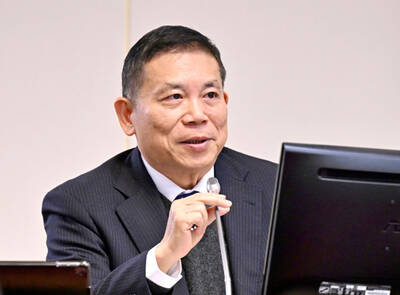The aviation industry is under pressure to do something about the immense amount of carbon emissions its engines generate. The output is accelerating many times faster than from sectors such as energy and agriculture, contributing to global warming.
Paul Eremenko, a 41-old former chief technology officer for Airbus SE and United Technologies Corp, thinks he has a solution: hydrogen-powered airplanes.
Of course, he well understands that his idea has a bit of a public relations problem right from the start. Hydrogen power and flight conjures up visions of the flaming Hindenburg airship.

Photo: AP
Yet his plan, backed by about US$8 million in initial private funding, is to start the transition with a better way to transport hydrogen and store it in the airplane, like a gas tank in a car.
Using hydrogen-powered fuel cells for aircraft is not a new idea. NASA already does and manufacturers have experimented for years with running small planes on them.
However, to become a viable business, planes would require a hydrogen fueling infrastructure that does not exist now — the same problem that has held back fuel-cell cars. Airports accustomed to loading planes with jet fuel lack the hydrogen pipelines and storage facilities to make that vision work.
So Eremenko’s start-up, called Universal Hydrogen Co, has developed Kevlar-coated, pill-shaped pods — about 2m in length and 1m in diameter — filled with hydrogen. The pods are designed to double as a storage container for transporting the hydrogen, by truck, train or other means, and a gas tank when loaded into a plane.
If filled with water, each would hold about 787 liters, and they can be stacked in racks so that 54 would fit inside a standard freight shipping container.
They can even be loaded into a plane with a forklift, he said.
The point is that airports would not need pipelines or underground tanks.
“We want to basically turn hydrogen into dry freight,” Eremenko said.
Universal Hydrogen has no interest in becoming an aircraft maker itself. Instead, starting in 2024, the company plans to offer not just the pods, but a retrofit kit for converting a 50-seat, single-aisle, regional aircraft to run on fuel cells — although making room for the capsules would mean the planes would only have 40 seats after the switch.
The converted planes would exist largely to show the industry how to make this future work.
Eremenko said that he wants the planes in the air before Boeing Co and Airbus decide on designs for replacing their own single-aisle planes, expected to happen in the next decade.
Although Universal Hydrogen would focus on planes with hydrogen fuel cells, the same pods could also one day be used to power planes that burn hydrogen in jet engines.
“There is fundamentally an incrementalist mindset in the incumbents,” Eremenko said. “Hydrogen is a fairly drastic step for the industry. I think it’s a necessary step, given the industry has no other way to meet the goals of the Paris agreement.”
Air travel accounts for about 2.5 percent of global greenhouse gas emissions, and before the pandemic at least, it was steadily growing. While some engineers are developing small electrified aircraft, current batteries are too heavy to power commercial planes on their own.
Airlines have run highly publicized flights on biofuel blends, but Eremenko considers biofuels a stopgap measure, even if they achieve mass production.
“You’re still burning hydrocarbons at altitude, with soot and aerosols,” he said.
Provided the hydrogen is generated from water by electrolysis using renewable power, it can be carbon-free. “Flight shaming” — the avoidance of airline travel due to its carbon footprint and the shaming of people who fly — would become a thing of the past.
Hydrogen has its own challenges to overcome in the air, of course. Ever since the Hindenburg burst into flames while docking in 1937, part of the public has viewed hydrogen warily.
However, its proponents, including companies that have explored hydrogen for powering cars as well as airplanes, consider that fear overblown.
As countless airplane and car crashes have shown, conventional fuels can be quite explosive on their own, and because it is so light, hydrogen rises when accidentally released, rather than pooling as jet fuel does.
Eremenko said that its is safer than jet fuel and believes the public, growing used to hydrogen-powered buses and cars that are already on the road, will get over its aversion.
Former Airbus chief executive officer Tom Enders, who is advising the start-up, said that the main market would be for medium-range, single-aisle aircraft.
While such planes are less commonly used in the US, they constitute the vast majority of aircraft worldwide, he said via e-mail.
“In other words, there is a huge market potential,” Enders said.
Eremenko formed the start-up with other aviation veterans after leaving United Technologies last year. The business has so far been self-funded, with about US$3 million from its core team and US$5 million from partners. To reach production, he estimated Universal Hydrogen would need to raise about US$300 million.
The same hydrogen storage solution, if successful in aviation, could one day be used in other industries, he said.
Cargo ship builders are also exploring fuel cells as a future power source, but Eremenko prefers to start with planes.
“Ultimately, we think aviation is the killer app, because aviation doesn’t have an alternative,” he said. “Also, it’s fun for us, because we’re aviation people.”

UNCERTAINTY: Innolux activated a stringent supply chain management mechanism, as it did during the COVID-19 pandemic, to ensure optimal inventory levels for customers Flat-panel display makers AUO Corp (友達) and Innolux Corp (群創) yesterday said that about 12 to 20 percent of their display business is at risk of potential US tariffs and that they would relocate production or shipment destinations to mitigate the levies’ effects. US tariffs would have a direct impact of US$200 million on AUO’s revenue, company chairman Paul Peng (彭雙浪) told reporters on the sidelines of the Touch Taiwan trade show in Taipei yesterday. That would make up about 12 percent of the company’s overall revenue. To cope with the tariff uncertainty, AUO plans to allocate its production to manufacturing facilities in

Taiwan will prioritize the development of silicon photonics by taking advantage of its strength in the semiconductor industry to build another shield to protect the local economy, National Development Council (NDC) Minister Paul Liu (劉鏡清) said yesterday. Speaking at a meeting of the legislature’s Economics Committee, Liu said Taiwan already has the artificial intelligence (AI) industry as a shield, after the semiconductor industry, to safeguard the country, and is looking at new unique fields to build more economic shields. While Taiwan will further strengthen its existing shields, over the longer term, the country is determined to focus on such potential segments as

Chizuko Kimura has become the first female sushi chef in the world to win a Michelin star, fulfilling a promise she made to her dying husband to continue his legacy. The 54-year-old Japanese chef regained the Michelin star her late husband, Shunei Kimura, won three years ago for their Sushi Shunei restaurant in Paris. For Shunei Kimura, the star was a dream come true. However, the joy was short-lived. He died from cancer just three months later in June 2022. He was 65. The following year, the restaurant in the heart of Montmartre lost its star rating. Chizuko Kimura insisted that the new star is still down

While China’s leaders use their economic and political might to fight US President Donald Trump’s trade war “to the end,” its army of social media soldiers are embarking on a more humorous campaign online. Trump’s tariff blitz has seen Washington and Beijing impose eye-watering duties on imports from the other, fanning a standoff between the economic superpowers that has sparked global recession fears and sent markets into a tailspin. Trump says his policy is a response to years of being “ripped off” by other countries and aims to bring manufacturing to the US, forcing companies to employ US workers. However, China’s online warriors